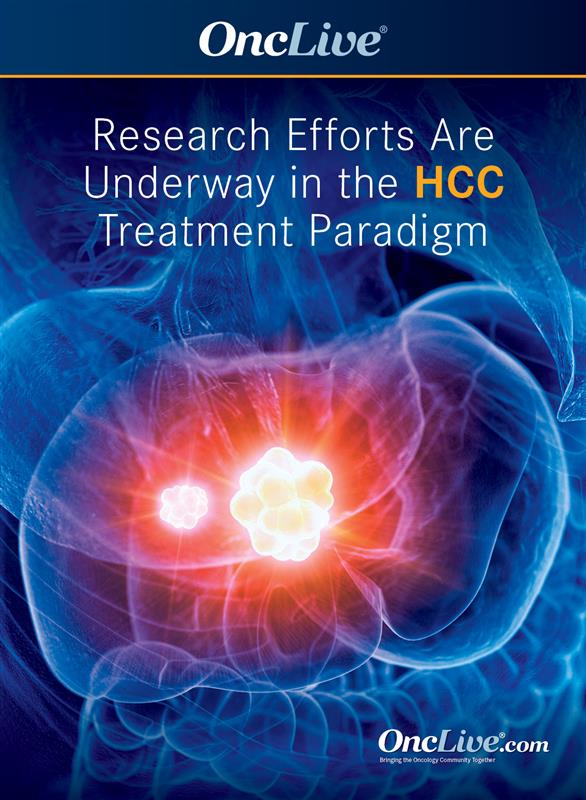News
Article
Supplements and Featured Publications
Frontline Camrelizumab/Rivoceranib Combination Shows Promise in Unresectable HCC
Author(s):
Amit Mahipal, MD, discusses data on camrelizumab plus rivoceranib in advanced HCC and the phase 3 CARES-310 trial, which is currently enrolling patients.
Amit Mahipal, MD

Investigators hope to add to the advanced hepatocellular carcinoma (HCC) treatment paradigm, which has gained new treatment options in recent years with the emergence of immune checkpoint inhibitors targeting PD-1/PD-L1, with the initiation of the phase 3 CARES-310 trial (NCT03764293). CARES-310 aims to overcome the modest response many patients experience with immune checkpoint inhibitor monotherapy by combining the IgG4, PD-1–directed monoclonal antibody camrelizumab with the novel VEGFR2-directed tyrosine kinase inhibitor (TKI) rivoceranib.1
"[Rivoceranib] blocks multiple pathways, but the main one is VEGF, which we know is very hyperactivated in HCC,” Amit Mahipal, MD, professor, hematology and oncology, University Hospitals Seidman Cancer Center, as well as a member of the Developmental Therapeutics Program, Case Comprehensive Cancer Center, both in Cleveland, Ohio, said in an interview with OncologyLive®. "Based on prior drug experience, we know that the anti-VEGF agents do work in this cancer. In CARES-310, [the investigators] tried a combination of anti–PD-1 plus VEGF [inhibition] and compared it with sorafenib [Nexavar], which was the standard of care.”
Early-Phase Findings Provide Proof Of Concept For Camrelizumab/Rivoceranib In HCC
The combination of camrelizumab plus rivoceranib was first evaluated for the treatment of patients with advanced HCC in a phase 1/2 trial (NCT02942329), which also enrolled patients with gastric or esophagogastric junction cancer. In the phase 1a portion, patients received camrelizumab at 200 mg every 2 weeks and rivoceranib at dose levels ranging from 125 to 500 mg/d until unacceptable toxicity or disease progression; rivoceranib was given as a part of the combination at the recommended phase 2 dose (RP2D) of 250 mg in phase 1b. The primary end points were safety and determining the RP2D.2
Findings from the study demonstrated that the objective response rate (ORR) in response-evaluable patients with HCC (n = 18) was 50% (95% CI, 24.7%-75.4%). In the safety population (n = 43), no dose-limiting toxicities (DLTs) were reported in the rivoceranib 125-mg cohort (n = 5), 1 grade 3 DLT of lipase elevation was reported in the 250-mg cohort (n = 33), and 3 patients in the 500-mg cohort (n = 5) experienced grade 3 immune-related pneumonitis. Common grade 1 or 2 treatment-related adverse effects (TRAEs) at the RP2D level included hypertension (42.4%), fatigue (39.4%), and proteinuria (36.4%).2
Following the promising findings from the phase 1 trial, investigators initiated the phase 2 RESCUE study (NCT03463876), which evaluated camrelizumab plus rivoceranib in patients with advanced HCC. The study enrolled patients who were on their first line of therapy or were refractory or intolerant to their first line of targeted therapy. Patients received camrelizumab 200 mg every 2 weeks in combination with oral rivoceranib 250 mg/d. The primary end point was ORR; secondary end points included duration of response (DOR), overall survival (OS), progression-free survival (PFS), and safety.3
Patients in the first-line cohort (n = 70) experienced an ORR of 34.3% (95% CI, 23.3%-46.6%) by independent review committee; the ORR was 22.5% (95% CI, 15.4%-31.0%) in the second-line cohort (n = 120). The median DOR was 14.8 months (95% CI, 5.5-not reached [NR]) and NR, respectively.3
The study authors concluded that the combination of camrelizumab and rivoceranib displayed a high ORR with durable responses and a manageable safety profile in advanced HCC. They noted that the combination could offer a novel treatment option in the first- or second-line setting in advanced HCC.
CARES-310 Trial Design
Given the positive phase 1 and phase 2 data, investigators initiated CARES-310, an open-label, international study of camrelizumab plus rivoceranib vs sorafenib for the frontline treatment of adult patients with unresectable HCC. To be eligible for enrollment, patients must also have at least 1 measurable lesion per RECIST 1.1, an ECOG performance status of 1 or less, a life expectancy of at least 12 weeks, adequate organ function, Child-Pugh grade A disease, and Barcelona Clinic Liver Cancer stage B or C disease. Those with moderate-to-severe ascites, HIV infection, symptomatic interstitial lung disease, or other active malignancies besides HCC within 5 years or simultaneously were not eligible.4
“It is worth mentioning that this study was primarily recruiting in Asia, although there were some European and US sites,” Mahipal said. “It certainly lends itself to drivers of HCC that impact liver disease in that part of the world, primarily hepatitis B. But that does not mean that the results may not be generalizable to a broader population.”
Patients were randomly assigned 1:1 to the camrelizumab plus rivoceranib arm (n = 272) or the sorafenib arm (n = 271). Intravenous camrelizumab 200 mg was administered every 2 weeks and oral rivoceranib 250 mg was given once daily. Patients in the control arm received oral sorafenib 400 mg twice daily. Treatment in both arms continued in 28-day cycles until progressive disease, unacceptable toxicity, or withdrawal by the patient or investigator.1
The coprimary end points were OS and PFS. Secondary end points included ORR, DOR, disease control rate, time to progression, and safety.
CARES-310 Produces Robust Data At Primary PFS Analysis
In September 2023, investigators published data from the primary PFS analysis and the interim OS analysis of CARES-310 in The Lancet. The data cutoff for PFS was May 10, 2021, and the cutoff for OS was February 8, 2022.1
At baseline, the median age in the combination arm was 58 years (range, 48-66) compared with 56 years (range, 47-64) in the monotherapy arm. Most patients in both arms were males (83% vs 85%), Asian (83% vs 83%), had an ECOG performance status of 1 (56% vs 57%), Barcelona Clinic Liver Cancer stage C (86% vs 85%), and a PD-L1 tumor proportion score of less than 1% (81% vs 78%).
At a median follow-up of 7.8 months (IQR, 4.1-10.6), the median PFS was 5.6 months (95% CI, 5.5-6.3) in the camrelizumab plus rivoceranib arm compared with 3.7 months (95% CI, 2.8-3.7) in the sorafenib arm (stratified HR, 0.52; 95% CI, 0.41-0.65; 1-sided log-rank P < .0001). The 6-month PFS rates were 48.2% (95% CI, 41.9%-54.3%) vs 25.3% (95% CI, 19.8%-31.1%), respectively, and the 12-month rates were 29.8% (95% CI, 24.1%-35.8%) vs 12.4% (95% CI, 8.3%-17.3%), respectively.
At a median follow-up of 14.5 months (IQR, 9.1-18.7), the median OS in the combination arm was 22.1 months (95% CI, 19.1-27.2) vs 15.2 months (95% CI, 13.0-18.5) in the monotherapy arm, conferring a reduction in the risk of death of 38% with the combination vs sorafenib (stratified HR, 0.62; 95% CI, 0.49-0.80; 1-sided log-rank P < .0001). The 12-month OS rates were 76.5% (95% CI, 71.0%-81.1%) vs 60.8% (95% CI, 54.6%-66.4%), respectively, and the 18-month OS rates were 60.9% (95% CI, 54.2%-66.9) vs 45.2% (95% CI, 38.8%-51.4%), respectively.
“This reminds me of data from the [phase 3] LEAP-002 study [NCT03713593] where lenvatinib [Lenvima] was used as the control arm,” Aiwu Ruth He, MD, PhD, scientific lead, liver and biliary cancers, MedStar Georgetown University Hospital, Washington, DC, said in an interview with OncologyLive. “The median OS of [that] TKI plus immunotherapy [regimen] was in the same ballpark as the CARES-310 regimen and the only difference is [that] the control arm was lenvatinib, which is the reason why that study was not positive.”
Since the findings for both primary end points of CARES-310 were significant, ORR by blinded independent review committee per RECIST 1.1 was evaluated sequentially. The confirmed ORR was 25% (95% CI, 20%-31%) in the combination arm compared with 6% (95% CI, 3%-9%) in the monotherapy arm (1-sided P < .0001). The median DOR was 14.8 months (95% CI, 8.4-NR) compared with 9.2 months (95% CI, 5.3-NR), respectively, although study authors noted that these data were not yet mature.
In terms of safety, TRAEs of any severity occurred in 97% of patients in the combination arm compared with 93% in the monotherapy arm. Grade 3 or higher TRAEs occurred in 81% vs 52% of patients, respectively. In the combination arm, the most common grade 3 or 4 TRAEs included hypertension (38%), increased aspartate aminotransferase (16%), and increased alanine aminotransferase (13%).
Study authors concluded that camrelizumab plus rivoceranib displayed a significant and clinically meaningful PFS and OS benefit compared with sorafenib for the treatment of patients with unresectable HCC. They highlighted that the median OS achieved by patients in the investigational arm of CARES-310 was the longest observed in any phase 3 trial evaluating a systemic therapy in unresectable HCC and noted that the combination could represent a new and effective frontline treatment option for these patients.
In July 2023, Elevar Therapeutics, the manufacturer of rivoceranib, announced that the FDA had accepted the new drug application (NDA) for the combination of rivoceranib and camrelizumab as a frontline treatment for patients with unresectable HCC. The NDA is supported by findings from CARES-310; the FDA set a Prescription Drug User Fee Act target action date of May 16, 2024, for the NDA. The combination also received approval from the National Medical Products Administration in China as a first-line therapy for patients with liver cancer.5 “CARES-310 is a positive trial and if the FDA approves [the regimen], it would be practice changing in the first line,” Mahipal said.
References
- Qin S, Chan SL, Gu S, et al. Camrelizumab plus rivoceranib versus sorafenib as first-line therapy for unresectable hepatocellular carcinoma (CARES-310): a randomised, open-label, international phase 3 study. Lancet. 2023;402(10408):1133-1146. doi:10.1016/S0140-6736(23)00961-3
- Xu J, Zhang Y, Jia R, et al. Anti-PD-1 antibody SHR-1210 combined with apatinib for advanced hepatocellular carcinoma, gastric, or esophagogastric junction cancer: an open-label, dose escalation and expansion study. Clin Cancer Res. 2019;25(2):515-523. doi:10.1158/1078-0432.CCR-18-2484
- Xu J, Shen J, Gu S, et al. Camrelizumab in combination with apatinib in patients with advanced hepatocellular carcinoma (RESCUE): a nonrandomized, open-label, phase II trial. Clin Cancer Res. 2021;27(4):1003-1011. doi:10.1158/1078-0432.CCR-20-2571
- A study to evaluate SHR-1210 in combination with apatinib as first-line therapy in patients with advanced HCC. ClinicalTrials.gov. Updated June 22, 2023. Accessed January 10, 2024. https://classic.clinicaltrials.gov/ct2/show/NCT03764293
- Elevar Therapeutics announces FDA acceptance for filing of new drug application for rivoceranib in combination with camrelizumab as a first-line treatment for unresectable hepatocellular carcinoma. News release. Elevar Therapeutics. July 17, 2023. Accessed January 10, 2024. https://www.globenewswire.com/news-release/2023/07/17/2705640/0/en/Elevar-Therapeutics-Announces-FDA-Acceptance-for-Filing-of-New-Drug-Application-for-Rivoceranib-in-Combination-with-Camrelizumab-as-a-First-line-Treatment-for-Unresectable-Hepatoce.html










